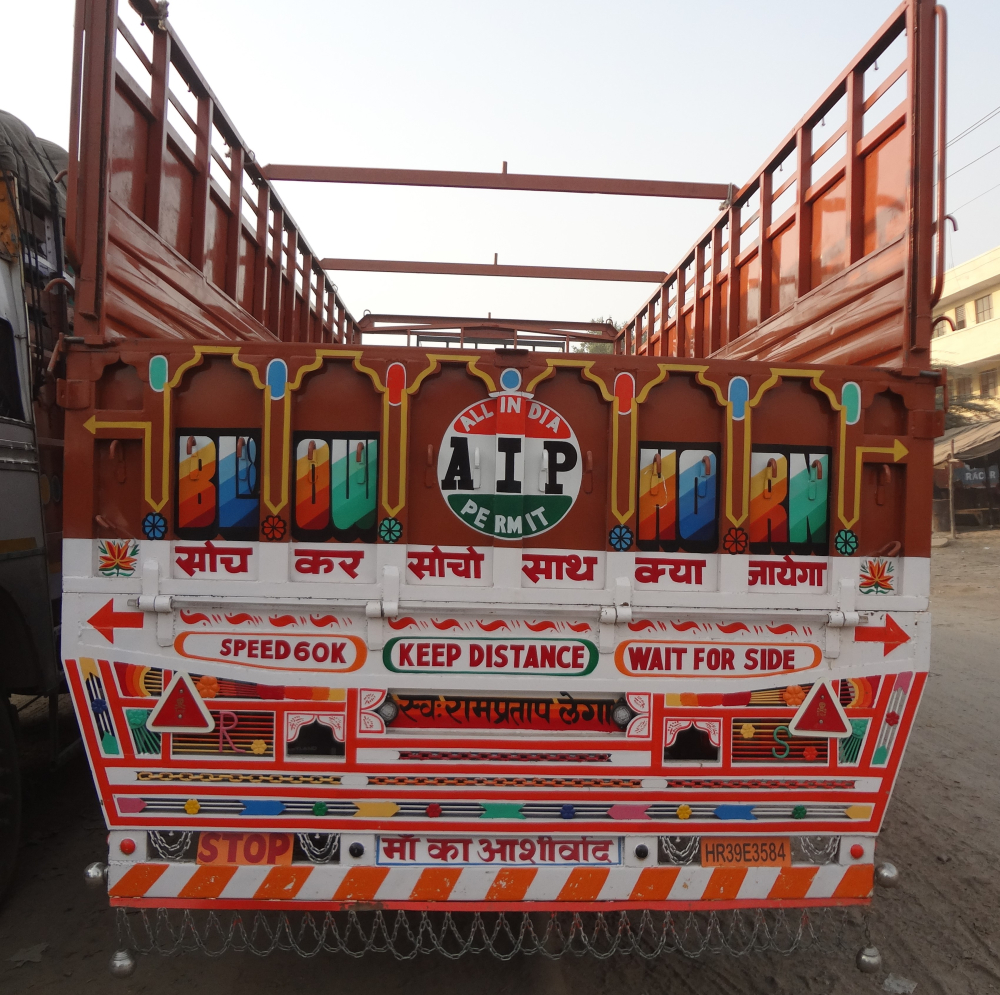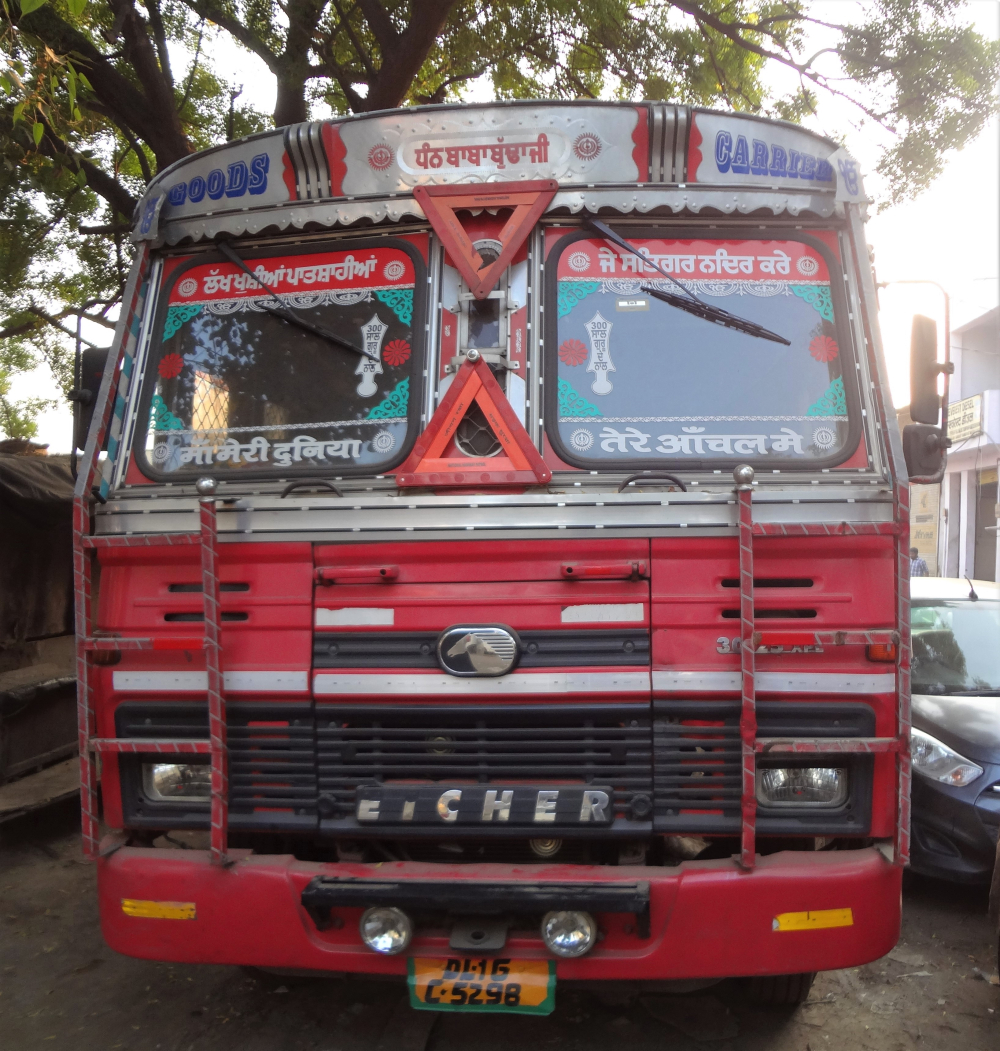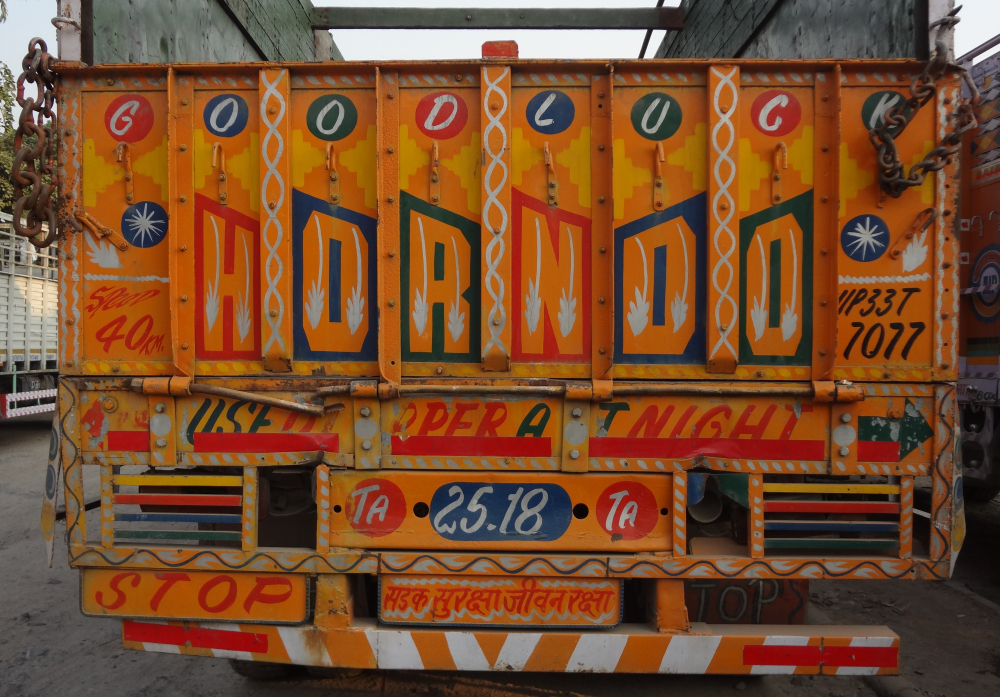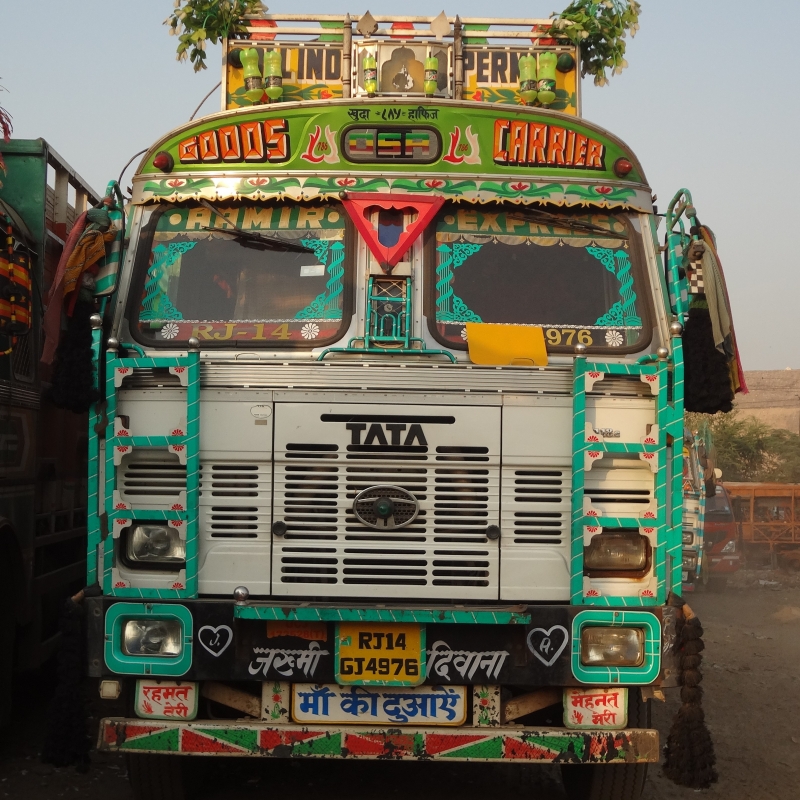Vijay Kumar Yadav, 40, is a truck driver from Sant Kabir Nagar in Uttar Pradesh. He likes to hum a couplet[1] when he drives his truck. It speaks of his predicament, he says, for ‘a driver has no home other than the truck he drives.’[2]
In his 20-year career as a driver, Yadav never got such a couplet written on the trucks he drives. He worries that the couplets, commonly known as shayaris (Urdu for poetry), written on the lateral bumpers of the trucks may cause accidents. ‘A driver reading the shayari on my truck might get distracted and end up hitting my truck or veering off the road. This is why I prefer to keep it simple,’ he says. Nonetheless, Yadav likes to hum these couplets during his travels. Having driven his truck all over India and Nepal, Yadav is familiar with the couplets and shayaris written on the bonnet of trucks.
At North Delhi’s Transport Nagar, Yadav follows me as I note and photograph the shayaris, couplets and one-liners written on the bonnets of trucks parked in the garages. He volunteers to recite a few such couplets that he remembers having frequently read on trucks while on the road: 'कम पियो मेरी रानी/ बहुत महंगा है इराक का पानी' (Drink less, My Dear/ For the Iraqi water is quite expensive); 'सजी हुँ, सँवरी हुँ, नजर मत लगाना/ जिन्दगी भर साथ दुँगी, पी कर मत चलाना' (I’m all decked up, but just don’t cast an evil eye on me/ I’ll always give you company, just don’t drink and drive).
Truck art forms a significant aspect of popular art in South Asia. It is an art form that makes elaborate use of paint, stickers, wood, and metal to decorate a truck and give it a distinct identity. Truck art constitutes portraits, floral designs, calligraphy, and extension of the truck’s body with the use of metal and wood. Truck art serves as a space for the self-expression of a driver, an owner or a painter of a truck, depending on who has the agency to decide how a particular truck should look like.
Considered to have originated in South Asia in the 1940s, truck art initially used a small spectrum of colours and minimal incorporation of religious iconography in the painting of trucks. But in the 1960s, it began to borrow elements from the psychedelic pop art, using images of pop culture icons and political leaders. Truck art is now considered to have taken a national identity in itself, with distinct colours, designs, iconography, and calligraphy being used in various countries across South Asia. Pakistani trucks are especially known for their psychedelic art paintings, excessive modifications, and bright colours that give them a distinct look and character. Indian trucks, in comparison, use a narrow spectrum of colours and have fewer modifications than the Pakistani ones. Nepali trucks, while similar to the Indian ones in terms of body design, use comparatively more calligraphy and poetry as decorative elements.
South Asian truck art has received considerable attention in the past several years, with scores of social media pages, including a Wikipedia entry devoted to it.[3] Its clout is also growing in mainstream media, with several outlets publishing features on the artists involved in the business. In early 2019, an art gallery named Art Show opened in Mumbai to showcase truck art. Set up in a truck itself, the mobile art gallery travels to several places around Mumbai.[4]
Truck literature is a sub-genre of truck art. It remains largely unexplored by mainstream as well as marginal social media. Truck literature involves the use of particular forms of text, painted on trucks for creative expression. Shayaris, couplets, and one-liners of such kinds form the essential decorative aspect of a large number of Indian trucks. Consisting of themes ranging from patriotism, education, religion, regionalism, and longing for home, such writing often reflects the ideas and ideologies of those associated with trucks—the drivers, helpers, and owners. Known as truck literature, such writing is also visible on several over kinds of public vehicles including pick-ups trucks and autorickshaws.
Changing Dynamics
Surinder Chhabra, 60, is a truck painter based in Sanjay Gandhi Transport Nagar in Delhi. Having painted trucks for over 40 years, Chhabra has been witness to the changing themes and patterns in Indian truck art and truck literature. He says he has fresh memories of painting elephant insignia on a large number of trucks in the 1980s after the 1982 Asian Games, whose mascot was the image of an elephant. He considers the truck art and truck literature of the 1980s and 1990s simpler and more straightforward than that of today: ‘These days, drivers make me write mostly useless things like “chaupaya”(quatrains).’[5]
Nonetheless, Chhabra concedes, the choices of the couplets or quatrains help us understand a particular driver’s personality. He says they also help us understand how drivers use iconography and calligraphy to express their collective identity as there is a certain pattern in which they express themselves. ‘Delhiite drivers ask for tiger and eagle insignia as it is a common theme of trucks registered in Delhi,’ says Chhabra, ‘And if the driver happens to be a Muslim, he would have an image of Taj Mahal painted on the truck.’[6] If the driver happens to be a Punjabi, Chhabra says, the truck more often than not uses the painting of a girl seemingly waiting for her lover’s homecoming, with the phrase, ‘Ghar kab aaoge?’ (When will you return home?). Another common feature of Punjabi trucks, Chhabra says, is the painting of images of Bhagat Singh, the revolutionary freedom fighter who was a native of Punjab.
Shubham Raj, 25, is a truck designer based at Sanjay Gandhi Transport Nagar in Delhi. He says the ‘Beti bachao beti padhao’ (Educate girls, save girls) slogan that the government of India envisaged for awareness of the rights of a girl child has become the default writing on most trucks in North India. [7] Raj says it gets easier to get a truck’s registration passed if slogans representing the government’s flagship programs are painted on the trucks. In Haryana, Raj says, officials make drivers purchase stickers with those slogans if they are not already painted or pasted on the trucks. ‘Their stickers cost 400 rupees, whereas we sell them for 200 rupees. So, drivers make sure to paint or paste such stickers beforehand just to be on the safe side,’ Raj adds.
Recurring Themes
Truck drivers and painters alike in Delhi’s Sanjay Gandhi Transport Nagar say that the slogans for the government’s flagship have remained a constant presence in Indian trucks. While ‘Jai jawan, jai kisan’ (Hail the soldiers and the farmers) represent a continuity in the relevance of the slogan given by Prime Minister Lal Bahadur Shashtri at a public gathering in Delhi’s Ram Lila Maidan in 1965, newer slogans such as ‘Beti bachao, beti padhao’ exemplify the changes in the government’s slogans in contemporary times. But apart from the oft-repetitive and generic slogans, truck literature encompasses a vast array of themes and issues ranging from popular aphorisms to social identity and from concerns on road safety to longing for home and beloved. An analysis of over 200 trucks registered at six different states/state territory of North India—Delhi, Haryana, Punjab, Rajasthan, Uttar Pradesh, and Jammu and Kashmir—showed that there is North Indian truck literature consisting mainly of four recurring themes: popular aphorisms; society, beliefs, and identity; traffic rules and road safety; and romance.
a) Popular aphorisms
A significant amount of truck literature reflects the general aphorisms that people live by. [Fig. 1]. These include lines attributed to various thinkers as well as those heard in daily life. The examples of such truck literature include:
- Beauty is only to see not to touch
- समय से पहले भाग्य से ज्यादा कभी नहीं मिलता (You don’t get anything before time, nor more than what fate has in store for you)
- कर्म ही पूजा है (Work is worship)
- सोच कर सोचो, साथ क्या जाएगा (Think with a thought what you will take along)
- बुरी नजर वाले तेरा मुँह काला (Those with evil eye will have their faces blackened)

b) Society, beliefs and identity
Drivers often get the names of their hometowns painted on the trucks. This may be interpreted in three ways: it is to assert a sense of identity within diverse and perhaps foreign spaces, through the naming the truck drivers feel closer to their home no matter where their work takes them, and to reflect on the risks involved in driving trucks and the blessings they need as they navigate the roads (Fig. 2). The examples of such truck literature include:
- Jai Hind
- Jai Mata Di
- Jai Vaishno Devi
- India is great
- Swachchh Bharat
- Gurjar chhora
- माता पिताका आशीर्वाद (Parents’ blessings)
- मेहनत मेरी रेहमत तेरी (My hard work and your blessings)
- साइँ इतना दिजिए जिसमे कुटुम्ब समाए/ में भी भूखा ना रहु साधु भी भूखा ना जाए (Sai Baba, please provide enough for my family/ Just enough to feed myself and the sage)
- माँ मेरी दुनिया तेरी आँचल में (Mother, my world is under the cool shadow of your shawl)
- मा बाप की दुआ, जन्नत कि हवा (Parents’ blessings, paradise’s environment)
- जन्नत ए कश्मीर (Paradise of Kashmir)
- यह नीम का पेड है, चन्दन से कम नहीं/ यह दिल्ली है, लन्दन से कम नहीं (This neem tree is no lesser than chandan/ This Delhi city is no lesser than London)

c) Traffic rules and road safety
A significant amount of literature reflects the acute awareness of the drivers about the risks involved in their profession [Fig. 3]. They, therefore, convey messages for their own safety as well as that of others on the road. They find some find quirky one-liners to convey their message:
- Keep distance
- Wait for side
- Blow horn
- Horn please
- Horn OK please
- Use dipper at night
- सुहाना सफर (Beautiful journey)
- सडक सुरक्षा, जीवन रक्षा (Road safety is your life’s safety)
- कम पियो मेरी रानी, बहुत महगा है इराक् की पानी (Drink less, Dear, for the Iraqi water is expensive)
- मलिक की गाडी, ड्राइवर का पसिना, रोड पे चल्ती है मेरी हसिना (Owner’s vehicle, driver’s sweat; on the road walks my muse)
- लटक मत बेटा पटक देगा (Don’t hang on the truck’s rails, or you’ll fall down)
- धिरे चल प्यारे, जिन्दगी अनमोल है (Drive slowly, Dear, for your life is precious)
- चल बसन्ती तेरी इज्जत का सवाल है (Move fast, Basanti, it is a matter of your reputation)
- दम है तो क्रास कर नहीं तो बरदास्त कर (Dare you overtake, or deal with it)

d) Romance
Truck literature has an abundance of quirky references to the drivers’ romantic feelings for their muse [Fig. 4]. Women as objects of desire remain at the core of truck literature, which could be due to the fact that truck driving is a male domain. While many such shayaris reflect a man’s flirtatious approach to women, others speak of his longing for, or separation from, his beloved. Some examples are:
- देखो मगर प्यार से (Look, but with love)
- जख्मी दिवाना (Broken-hearted lover)
- तुम कब आओगे (When will you return)
- तु चल में आता हुँ (You go ahead, I will come)
- फिर मिलेङ्गे (See you again)
- देख सजनी तेरा साजन जा रहा है (Look dear, your beloved is leaving)
- दिल का क्या कसूर, दिल तो पगल है (What is the fault of my heart; it is mad after all)
- गुस्सा नहीं पगली, प्यार चाहिए (I need your love, not anger)
- ज्यादा खाएगी, मोटी हो जाएगी (Do not eat much, or you will turn fat)
- हस मत पगली प्यार हो जाएगा (Do not laugh, Silly Girl, or you will fall in love)
- दिल किसी के प्यार में बेकरार मत करना/ में तो ठेहरा परदेशी मेरा इन्तजार मत करना (Do not be restless in someone’s love/ Do not wait for me, for I do not belong to this place)
Truck Literature in Decline
Truck literature constitutes a significant aspect of popular culture that depicts contemporary beliefs and trends in the society. The survey at the Sanjay Gandhi Transport Nagar, however, revealed that contemporary truck literature is on the decline. It is facing two major changes: policy changes and technological changes.
Policy changes involve clampdown on advertisements on trucks. Shayaris come under the category of advertisements, which are not allowed on commercial trucks. Truck professionals say that shayaris that are sexist or misogynistic especially attract the ire of traffic police officers. Tota Ram, a driver, said when he was driving in Assam, he was accosted by a police officer who found 'Dilli ki chhamiya' (Delhi’s ‘item’ girl) written on the frontal bumper of his truck. He says the police officer let him off with a warning to not get such ‘derogatory’ terms written on his truck. He has not yet removed the paint, but he is not keen to get any other phrase or shayari painted on his truck.[8]
According to Raj, the truck literature has seen a sharp decline after the after the new Motor Vehicles (Amendment) Act came into effect from September 1, 2019. [9] The new act recommends stricter punishments and higher penalties for violation of traffic rules, including modification of any part of a vehicle in variance with the specifications mentioned by the manufacturer. Although painting a truck does not fall under modification, drivers say, traffic police officers often claim that having a shayari written on the body of a truck is considered modification. With a steep hike in fines related to violation of traffic rules, drivers like Tota Ram are worried having a shayari written on a truck is certain to get undesirable attention of traffic police personnel.
However, truck painter Chhabra points out that truck literature started struggling due to technological changes.[10] A significant number of artworks, Chhabra says, has been replaced with customised radium tapes which are more convenient and cheaper than paint work. While the mass production of such tapes means that they are cheaper, there are options for customised carvings that align with personal interests of the drivers. This, Raj says, helps drivers keep altering the decoration of the trucks as well as get their favourite lines pasted on the trucks without having to look for a truck artist.[11]
I spoke to Tejinder Pal Singh of Captain Radium Place in Sanjay Gandhi Transport Nagar who has been running a radium tape business for the past five years. Singh specialises in designing custom stickers and tapes that are pasted on trucks. He designs radium tapes with shayaris written on them with the help of a printing machine. Singh says the front panel of a truck is nowadays usually covered with radium tapes, with even the shayaris printed on stickers (Fig. 4; sticker on frontal bumper).[12]
While radium tapes provide a cheaper alternative to painting, they also consume relatively lesser time than painting. Moreover, radium tapes pasted on trucks increase the visibility of the trucks as they reflect the light of the vehicles coming from the opposite direction. Truck artist Chhabra and radium sticker designer Tejinder Singh both agree that radium stickers lower the risk of accidents, hence the increasing attraction of truck professionals including drivers towards it. But the fact that the front side of the trucks are almost entirely plastered by radium tapes and stickers, and much of the lateral side is also covered by the tapes and stickers entails that the space for shayaris and couplets is compromised, leading to a decline in the writing of truck literature.
Notes
[1] ‘गाडी मेरी घर है, त्रीपाल मेरी कफन है/ या खुदा मुझे क्या मालुम्, कहाँ मेर वतन है’ (The truck is my home, the tarpaulin is my shroud/ How would I know, my lord, where my country is?).
[2] Vijay Kumar Yadav, in conversation with the author, October 13, 2019.
[3] ‘Truck art in South Asia.’
[4] Tahseen, ‘Horn ok please: India’s first truck art gallery rolls into town.’
[5] Surinder Chhabra, in conversation with the author, October 14, 2019.
[6] Ibid.
[7] Shubham Raj, in conversation with the author, October 14, 2019.
[8] Tota Ram, in conversation with the author, October 13, 2019.
[9] Raj, in conversation with the author, October 14, 2019.
[10] Surinder Chhabra, in conversation with the author, October 14, 2019.
[11] Raj, in conversation with the author, October 14, 2019.
[12] Tejinder Pal Singh, in conversation with the author, October 14, 2019.
Bibliography
Aryal, Timothy. ‘Verses on vehicles—art or annoyance?’ The Kathmandu Post, June 18, 2019. Accessed September 29, 2019. https://kathmandupost.com/art-entertainment/2019/06/18/verses-on-vehiclesart-or-annoyance.
McKenzie, Sheena. ‘Pimp my ride: The psychedelic world of Indian truck art.’ CNN. August 6, 2015. Accessed September 30, 2019. https://edition.cnn.com/travel/article/india-truck-art-travel-design/index.html.
Sharma, Manoj. ‘Meet the men who convert trucks into colourful canvases.’ Hindustan Times, New Delhi, April 20, 2015. Accessed October 10, 2019. https://www.hindustantimes.com/india/meet-the-men-who-convert-trucks-into-colourful-canvases/story-mmF7FbEhGr2FUfpIwqTi1M.html.
Spitzer, Elianna. ‘Pakistan’s hypnotizing truck art.’ The Week. (n.d.). Accessed Feb 2, 2021. https://theweek.com/captured/712573/pakistans-hypnotizing-truck-art
Tahseen, Ismat. ‘Horn ok please: India’s first truck art gallery rolls into town.’ The Times of India, New Delhi, January 20, 2019. Accessed October 10, 2019. http://timesofindia.indiatimes.com/articleshow/67610210.cms?utm_source=contentofinterest&utm_medium=text&utm_campaign=cppst.
Vice. ‘Inside the World of Indian Truck Art.’ Vice. July 5, 2019. Accessed October 5, 2019. https://www.vice.com/en_in/article/a3xpk5/inside-the-world-of-india-truck-art.
‘Truck art in South Asia.’ Wikipedia. Last modified December 13, 2019. https://en.wikipedia.org/wiki/Truck_art_in_South_Asia.













